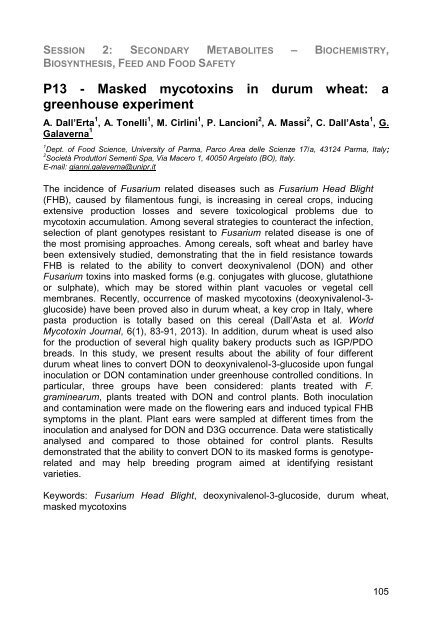EFS12- Book of abstracts - Contact
EFS12- Book of abstracts - Contact
EFS12- Book of abstracts - Contact
You also want an ePaper? Increase the reach of your titles
YUMPU automatically turns print PDFs into web optimized ePapers that Google loves.
SESSION 2: SECONDARY METABOLITES – BIOCHEMISTRY,<br />
BIOSYNTHESIS, FEED AND FOOD SAFETY<br />
P13 - Masked mycotoxins in durum wheat: a<br />
greenhouse experiment<br />
A. Dall’Erta 1 , A. Tonelli 1 , M. Cirlini 1 , P. Lancioni 2 , A. Massi 2 , C. Dall’Asta 1 , G.<br />
Galaverna 1<br />
1 Dept. <strong>of</strong> Food Science, University <strong>of</strong> Parma, Parco Area delle Scienze 17/a, 43124 Parma, Italy;<br />
2 Società Produttori Sementi Spa, Via Macero 1, 40050 Argelato (BO), Italy.<br />
E-mail: gianni.galaverna@unipr.it<br />
The incidence <strong>of</strong> Fusarium related diseases such as Fusarium Head Blight<br />
(FHB), caused by filamentous fungi, is increasing in cereal crops, inducing<br />
extensive production losses and severe toxicological problems due to<br />
mycotoxin accumulation. Among several strategies to counteract the infection,<br />
selection <strong>of</strong> plant genotypes resistant to Fusarium related disease is one <strong>of</strong><br />
the most promising approaches. Among cereals, s<strong>of</strong>t wheat and barley have<br />
been extensively studied, demonstrating that the in field resistance towards<br />
FHB is related to the ability to convert deoxynivalenol (DON) and other<br />
Fusarium toxins into masked forms (e.g. conjugates with glucose, glutathione<br />
or sulphate), which may be stored within plant vacuoles or vegetal cell<br />
membranes. Recently, occurrence <strong>of</strong> masked mycotoxins (deoxynivalenol-3glucoside)<br />
have been proved also in durum wheat, a key crop in Italy, where<br />
pasta production is totally based on this cereal (Dall’Asta et al. World<br />
Mycotoxin Journal, 6(1), 83-91, 2013). In addition, durum wheat is used also<br />
for the production <strong>of</strong> several high quality bakery products such as IGP/PDO<br />
breads. In this study, we present results about the ability <strong>of</strong> four different<br />
durum wheat lines to convert DON to deoxynivalenol-3-glucoside upon fungal<br />
inoculation or DON contamination under greenhouse controlled conditions. In<br />
particular, three groups have been considered: plants treated with F.<br />
graminearum, plants treated with DON and control plants. Both inoculation<br />
and contamination were made on the flowering ears and induced typical FHB<br />
symptoms in the plant. Plant ears were sampled at different times from the<br />
inoculation and analysed for DON and D3G occurrence. Data were statistically<br />
analysed and compared to those obtained for control plants. Results<br />
demonstrated that the ability to convert DON to its masked forms is genotyperelated<br />
and may help breeding program aimed at identifying resistant<br />
varieties.<br />
Keywords: Fusarium Head Blight, deoxynivalenol-3-glucoside, durum wheat,<br />
masked mycotoxins<br />
105
















![Présentation CRB-anim [Mode de compatibilité] - Inra](https://img.yumpu.com/17418636/1/190x135/presentation-crb-anim-mode-de-compatibilite-inra.jpg?quality=85)